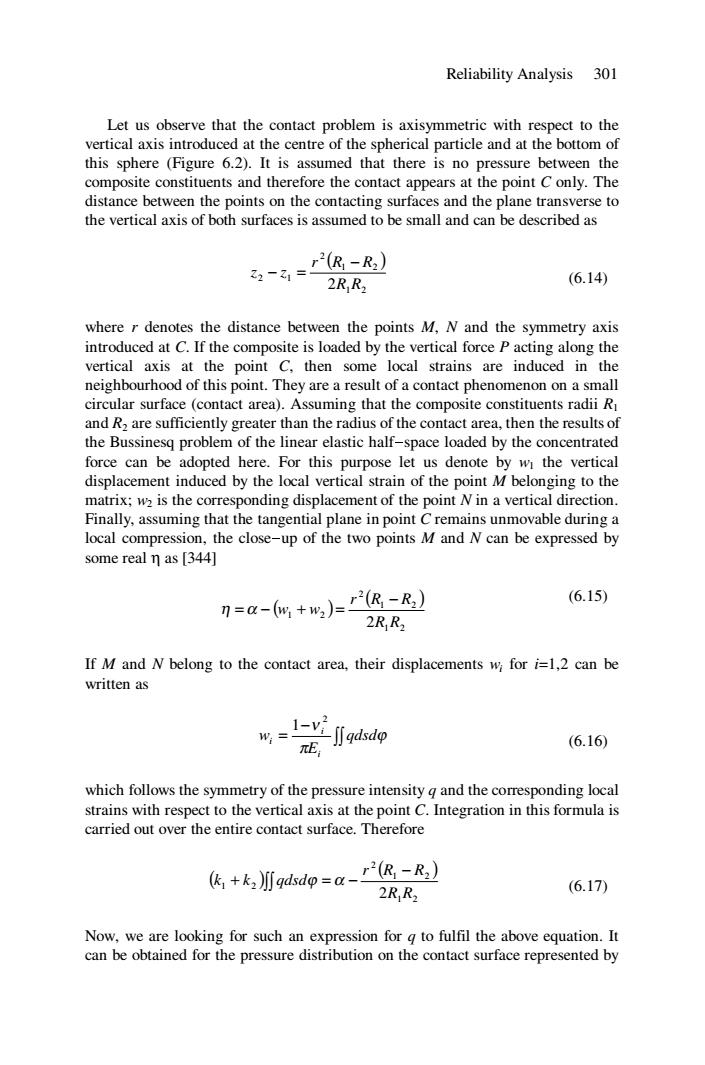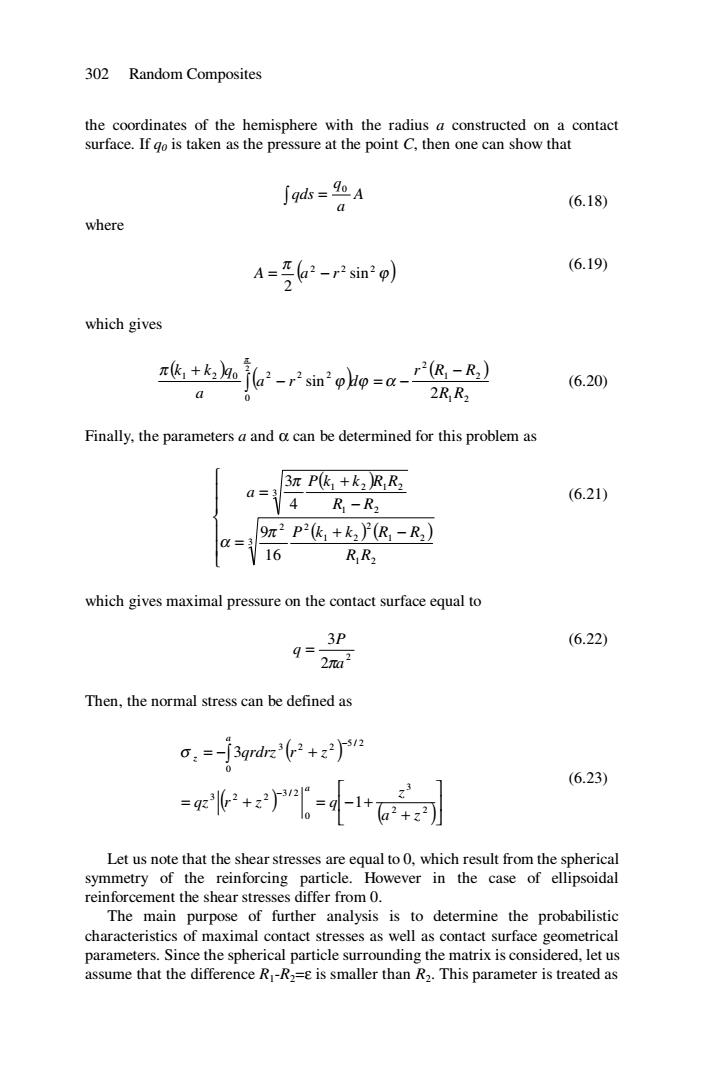
Reliability Analysis 301 Let us observe that the contact problem is axisymmetric with respect to the vertical axis introduced at the centre of the spherical particle and at the bottom of this sphere (Figure 6.2).It is assumed that there is no pressure between the composite constituents and therefore the contact appears at the point C only.The distance between the points on the contacting surfaces and the plane transverse to the vertical axis of both surfaces is assumed to be small and can be described as 2(R-R2) 22-31= 2R R, (6.14) where r denotes the distance between the points M,N and the symmetry axis introduced at C.If the composite is loaded by the vertical force P acting along the vertical axis at the point C,then some local strains are induced in the neighbourhood of this point.They are a result of a contact phenomenon on a small circular surface (contact area).Assuming that the composite constituents radii R and R2 are sufficiently greater than the radius of the contact area,then the results of the Bussinesq problem of the linear elastic half-space loaded by the concentrated force can be adopted here.For this purpose let us denote by wi the vertical displacement induced by the local vertical strain of the point M belonging to the matrix;w2 is the corresponding displacement of the point N in a vertical direction. Finally,assuming that the tangential plane in point C remains unmovable during a local compression,the close-up of the two points M and N can be expressed by some real n as [344] 刀=a-6m+w,)=R-R) (6.15) 2RR2 If M and N belong to the contact area,their displacements w for i=1,2 can be written as =1x小gkd πE (6.16) which follows the symmetry of the pressure intensity q and the corresponding local strains with respect to the vertical axis at the point C.Integration in this formula is carried out over the entire contact surface.Therefore k+k川gddp=a-民-R) (6.17) Now,we are looking for such an expression for g to fulfil the above equation.It can be obtained for the pressure distribution on the contact surface represented by
Reliability Analysis 301 Let us observe that the contact problem is axisymmetric with respect to the vertical axis introduced at the centre of the spherical particle and at the bottom of this sphere (Figure 6.2). It is assumed that there is no pressure between the composite constituents and therefore the contact appears at the point C only. The distance between the points on the contacting surfaces and the plane transverse to the vertical axis of both surfaces is assumed to be small and can be described as ( ) 1 2 1 2 2 2 1 2R R r R R z z − − = (6.14) where r denotes the distance between the points M, N and the symmetry axis introduced at C. If the composite is loaded by the vertical force P acting along the vertical axis at the point C, then some local strains are induced in the neighbourhood of this point. They are a result of a contact phenomenon on a small circular surface (contact area). Assuming that the composite constituents radii R1 and R2 are sufficiently greater than the radius of the contact area, then the results of the Bussinesq problem of the linear elastic half-space loaded by the concentrated force can be adopted here. For this purpose let us denote by w1 the vertical displacement induced by the local vertical strain of the point M belonging to the matrix; w2 is the corresponding displacement of the point N in a vertical direction. Finally, assuming that the tangential plane in point C remains unmovable during a local compression, the close-up of the two points M and N can be expressed by some real η as [344] ( ) ( ) 1 2 1 2 2 1 2 2R R r R R w w − η = α − + = (6.15) If M and N belong to the contact area, their displacements wi for i=1,2 can be written as ∫∫ − = ϕ π ν qdsd E w i i i 2 1 (6.16) which follows the symmetry of the pressure intensity q and the corresponding local strains with respect to the vertical axis at the point C. Integration in this formula is carried out over the entire contact surface. Therefore ( ) ( ) 1 2 1 2 2 1 2 2R R r R R k k qdsd − + ∫∫ ϕ = α − (6.17) Now, we are looking for such an expression for q to fulfil the above equation. It can be obtained for the pressure distribution on the contact surface represented by

302 Random Composites the coordinates of the hemisphere with the radius a constructed on a contact surface.If go is taken as the pressure at the point C,then one can show that qds=10A a (6.18) where A--sin) (6.19) which gives k+血6:-r产n'pp=a-图-) (6.20) a 2RR2 Finally,the parameters a and a can be determined for this problem as 3 P(k +k2 RR2 a=3 (6.21) 4 R-R2 9n2 P2(k+k2)(R-R2) 16 RR which gives maximal pressure on the contact surface equal to 3P (6.22) 9= 2a2 Then,the normal stress can be defined as o:=-J3grdrz (6.23) -1*石4同 Let us note that the shear stresses are equal to 0,which result from the spherical symmetry of the reinforcing particle.However in the case of ellipsoidal reinforcement the shear stresses differ from 0. The main purpose of further analysis is to determine the probabilistic characteristics of maximal contact stresses as well as contact surface geometrical parameters.Since the spherical particle surrounding the matrix is considered,let us assume that the difference R-R2=e is smaller than R2.This parameter is treated as
302 Random Composites the coordinates of the hemisphere with the radius a constructed on a contact surface. If q0 is taken as the pressure at the point C, then one can show that A a q qds 0 ∫ = (6.18) where ( ) ϕ π 2 2 2 sin 2 A = a − r (6.19) which gives ( ) ( ) ( ) 1 2 1 2 2 0 1 2 0 2 2 2 2 sin 2 R R r R R a r d a k k q − − = − + ∫ ϕ ϕ α π π (6.20) Finally, the parameters a and α can be determined for this problem as ( ) ( )( ) ⎪ ⎪ ⎩ ⎪ ⎪ ⎨ ⎧ + − = − + = 3 1 2 1 2 2 1 2 2 2 3 1 2 1 2 1 2 16 9 4 3 R R P k k R R R R P k k R R a π α π (6.21) which gives maximal pressure on the contact surface equal to 2 2 3 a P q π = (6.22) Then, the normal stress can be defined as ( ) ( ) ( )⎥ ⎦ ⎤ ⎢ ⎣ ⎡ + = + = − + = − + − − ∫ 2 2 3 0 3 / 2 3 2 2 0 5 / 2 3 2 2 1 3 a z z qz r z q qrdrz r z a a σ z (6.23) Let us note that the shear stresses are equal to 0, which result from the spherical symmetry of the reinforcing particle. However in the case of ellipsoidal reinforcement the shear stresses differ from 0. The main purpose of further analysis is to determine the probabilistic characteristics of maximal contact stresses as well as contact surface geometrical parameters. Since the spherical particle surrounding the matrix is considered, let us assume that the difference R1-R2=ε is smaller than R2. This parameter is treated as